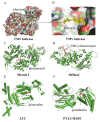Review on Structures of Pesticide Targets
- PMID: 32998191
- PMCID: PMC7582455
- DOI: 10.3390/ijms21197144
Review on Structures of Pesticide Targets
Abstract
Molecular targets play important roles in agrochemical discovery. Numerous pesticides target the key proteins in pathogens, insect, or plants. Investigating ligand-binding pockets and/or active sites in the proteins' structures is usually the first step in designing new green pesticides. Thus, molecular target structures are extremely important for the discovery and development of such pesticides. In this manuscript, we present a review of the molecular target structures, including those of antiviral, fungicidal, bactericidal, insecticidal, herbicidal, and plant growth-regulator targets, currently used in agrochemical research. The data will be helpful in pesticide design and the discovery of new green pesticides.
Keywords: agrochemicals; molecular targets; pesticides; review; structures.
Conflict of interest statement
The authors declare no conflict of interest.
Figures



References
-
- Clemens L., Stephane J., Torsten L., Andrew P. Current challenges and trends in the discovery of agrochemicals. Science. 2013;341:742–746. - PubMed
-
- Turner J.A. The Pesticide Manual. 17th ed. British Crop Protection Council; Hampshire, UK: 2015. pp. 1–1440.
-
- Fungicide Resistance Action Committee Fungal Control Agents Sorted by Cross Resistance Pattern and Mode of Action. [(accessed on 16 August 2020)];2020 Available online: https://www.frac.info/
-
- IRAC International MoA Working Group IRAC Mode of Action Classification Scheme. [(accessed on 16 August 2020)];2020 Available online: https://irac-online.org/modes-of-action/
-
- The Global Herbicide Resistance Action Committee HRAC Mode of Action Classification. [(accessed on 16 August 2020)];2020 Available online: https://www.hracglobal.com/herbicide-resistance.
Publication types
MeSH terms
Substances
LinkOut - more resources
Full Text Sources
Other Literature Sources
Medical

